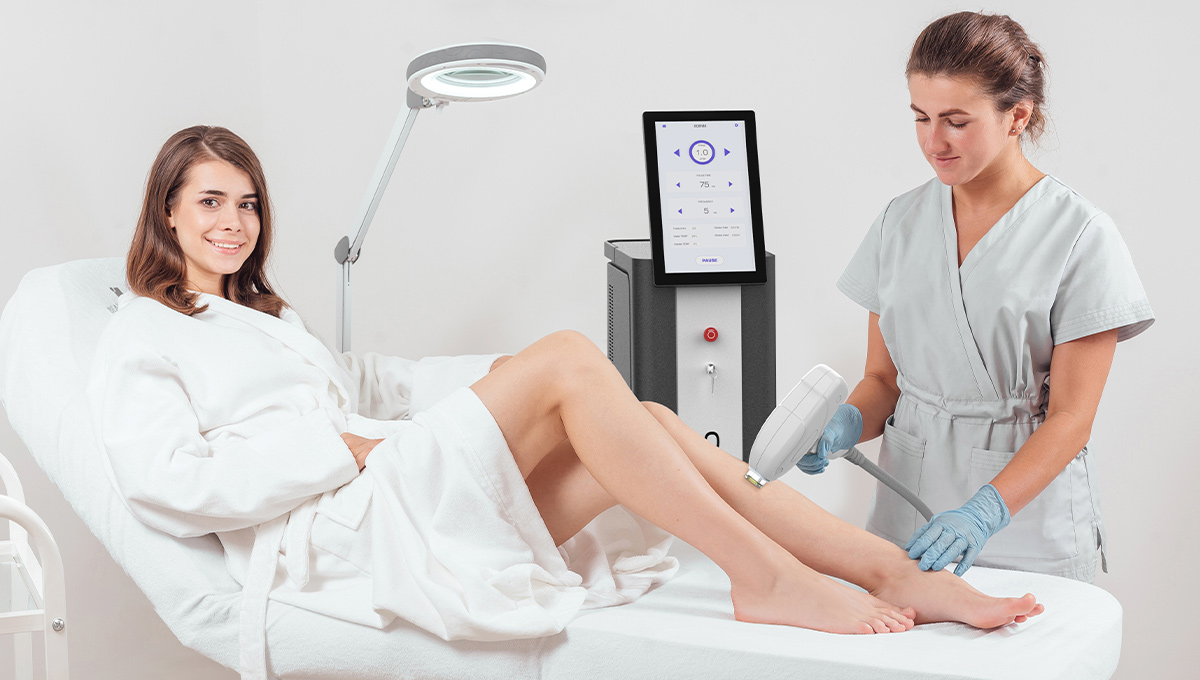Electrolysis for Permanent Hair Removal
Are you sick of shaving, waxing, or plucking undesirable hair? Temporary hair removal techniques break the hair follicle. However, their roots and stem cells remain intact, allowing hair regrowth. This is where electrolysis permanent hair removal treatment comes to rescue.
A small needle is inserted into each hair follicle. The hair root receives a low-level current of electricity through this needle, which produces heat. The heat destroys the cells that are in charge of hair growth generated during electrolysis.
Electrolysis aims to offer long-lasting treatment, unlike the temporary techniques like shaving or waxing. The overall effect is usually permanent, though you may need several sessions for the best outcomes.
Electrolysis is a hair removal method that damages the hair follicle using electrical energy. It offers an accurate and dependable way to permanently remove hair. It is particularly useful in regions where you seek long-term effects.
What is Electrolysis?
Your dermatologist or a professionally trained technician will insert a small wire into each hair follicle in the region you want to be treated. After that, heat generated by an electrical current will kill the hair follicle and its root sent down the wire.
Hair falls out and ceases to grow again when the hair follicle and root are destroyed. With its careful targeting of individual follicles, this procedure ensures that only the undesired hair is impacted. It is a flexible option for permanent hair removal because it works well on various hair types and colors.
Your electrologist will create a personalized, private plan of action based on your consultation. This will address your unique hair removal needs.
Suitability and Skin Types
Many factors can affect electrolysis efficiency, including skin color, type, and hair features. Although the procedure’s efficiency varies, it is usually suitable for all skin types.
Skin tone influences electrolysis; darker skin tones find the process more difficult. This is because the difference between dark skin and hair makes it more difficult for the technician to see the hair follicles precisely. Now that technology has advanced and practitioners are trained, they can use electrolysis for permanent hair removal on various skin tones.
Hair types also affect how well electrolysis works. Generally speaking, thick, coarse hair works better for the technique than fine hair. Additionally, the color of the hair influences the therapy.
Determining the best method and conditions for electrolysis requires understanding your unique skin and hair features. To maintain safety and effectiveness, technicians might need to modify the settings.
Electrolysis vs. Laser Hair Removal
Two popular techniques for removing unwanted hair are electrolysis for permanent hair removal and laser hair removal. You can find a detailed comparison of Electrolysis Vs. Laser hair removal here.
Electrolysis uses a tiny needle to destroy specific hair follicles with electric currents. This provides a permanent cure. All skin and hair kinds can benefit from it, but because it treats each follicle individually, it can take some time.
However, laser hair removal reduces hair growth. It uses concentrated light beams to target hair follicles. Although it can cover bigger regions more quickly than electrolysis, long-term benefits sometimes require numerous sessions.
One significant distinction is permanence. Laser hair removal offers only a long-lasting reduction. In contrast, you can use electrolysis hair removal for permanent smooth skin. When treating larger areas, doctors typically use lasers. Electrolysis is considered more adaptable for minor areas, like facial hair.
Consider your priorities: electrolysis may be your best option if you have patience and seek a permanent removal. Laser hair removal can be better if you aim for a quicker, more permanent reduction over bigger regions. Consulting professionals will help you determine the perfect fit for your unique demands.
Preparing for Electrolysis
Visit for Consultation
An electrolysis consultation is the first stage in the electrolysis process. During this consultation, you will go over the specifics of the electrolysis treatment. You will also learn how it eliminates hair permanently. You’ll talk about any worries you might have and get the answers to questions.
Stay Hydrated
Well-hydrated skin may make the procedure more comfortable. It also does a better job of conducting the therapeutic electrical currents. Thus, during the week preceding your appointment, particularly the day before, ensure you consume a lot of water. Try to stay away from substances like caffeine and alcohol that dry your skin.
Do not Shave or Wax
Avoid using temporary hair removal techniques in the days before your visit. Before your electrolysis appointment, refrain from shaving for three to five days and waxing or plucking for two to three weeks. There must be at least 1/8th of an inch of hair over the skin’s surface for the needle to follow the hair follicle and then readily remove the hair.
Avoid Chemicals
Products containing strong chemicals that could irritate your skin during the treatment—like prescription retinol—are the only ones you should avoid before your visit.
Mentally Prepare for Some Pain
Indeed, electrolysis may cause some discomfort. Everybody experiences pain differently and has varying thresholds for pain. Many individuals compare the sensation of electrolysis to a slight pinch or the feeling of their hair being pulled.
Take an anti-inflammatory pain medication 30 to 60 minutes before your session if you think you have a reduced pain threshold and are concerned about experiencing pain throughout your treatment. To help with pain management, your doctor may apply a light-numbing medication to the affected area before the procedure.
The Electrolysis Procedure
An experienced technician will clean the treatment area before the electrolysis process begins. The technician will then puncture each hair follicle with a tiny, thin needle. Passing a small amount of electrical current via the needle destroys the hair-growing cells through the heat produced.
The size of the area being treated determines how long the treatment takes. The process could take less time for smaller regions, like the face, and more time for bigger areas. You could feel anything from a small stinging to mild discomfort during the process. There may be some discomfort or swelling after the procedure, but these side effects usually disappear quickly.
With customized care depending on the size and region of the targeted area, the electrolysis process is an organized and efficient way to remove hair permanently.
Aftercare and Side Effects
Particularly in the first 48 hours of electrolysis treatments, giving the treated area considerable attention is crucial. This will enable the skin to stabilize, restore its natural heat response, and stop the treated areas from becoming infected.
Side Effects
The treated region and surrounding skin may feel heated for up to 48 hours.
Redness, swelling, and irritation of the skin in the area being treated can occur for up to 48 hours.
Tiny scabs or pin dot crusting could develop in the treated area.
During the healing procedure, the skin may become itchy.
Aftercare
Avoid picking at any potential scabs that may form, rubbing the treated region, and getting a fake or self-tan since these might irritate the skin.
You should also stay away from fragrant body lotions and self-tans.
Steer clear of sunbed treatments and direct sunshine.
Use a high-protection factor sunscreen with at least SPF 30 to prevent hyperpigmentation.
Saunas, solariums, sun beds, jacuzzis, and steam treatments should be avoided since they can also lead to the development of pigmentation.
It is also important to avoid hot baths and showers.
Steer clear of swimming.
Do not use makeup on the region that has been treated.
Refrain from cleaning the treated area with soap or scented items.
Avoid engaging in activities that increase blood flow for 48 hours.
Avoid clothes that are too tight or constricting over the treated area.
Conclusion
In conclusion, electrolysis is a fantastic option if you want to remove undesired hair permanently, have hirsutism, have a reasonable pain threshold, and are willing to stick with the procedure over the long term.
Your skin or hair color is not a barrier in the procedure. On the other hand, electrolysis might not be the best option if you value quickness above all else. It might also not be the best option if you are extremely sensitive to discomfort, want fast fixes, or value less expensive temporary remedies. Medical issues could potentially affect you. Speak with an electrologist to receive a customized evaluation.
FAQs
Does electrolysis remove hair permanently?
Hair of all skin tones can be permanently and safely removed using electrolysis. Permanent hair removal by electrolysis is the only procedure with FDA approval. The hair follicles’ growth cells are irreversibly destroyed by electrolysis, so the hair cannot regrow.
How many electrolysis sessions are needed for permanent hair removal?
Considering the density and length of the hair is necessary. The number of sessions required to eliminate hair follicles increases with their quantity. Furthermore, at least two targeting sessions are required for most hair follicles to be permanently affected. Eight to twelve sessions should be anticipated to achieve a lasting result.
Is electrolysis better than laser?
Although electrolysis eliminates hair growth, whereas laser hair removal only slows it down, it is considered a more permanent option than laser hair removal. However, electrolysis takes more individual sessions—roughly 14—and the sessions can take longer.
Does hair grow back after electrolysis?
It’s a common misconception that after just one treatment, hair never comes back. In truth, this belief is false. The therapies have progressive effects. This implies that the hair takes longer to grow again after each treatment. Hair grows back finer and lighter, until it finally stops growing altogether.
How painful is electrolysis?
Electrolysis causes a fair amount of pain. But advances in technology lessen this pain. In any case, your physician can provide you with an anesthetic cream if you find it to be extremely uncomfortable.
What are the risks of electrolysis?
It is normal to have a certain amount of redness around the treated hair follicles for a few days. Electrolysis carries several potential dangers, including increased or decreased pigmentation or brown or white markings. The reactivation of herpes simplex is one potential consequence. Another potential consequence is a secondary bacterial infection of the area, also known as impetigo.



